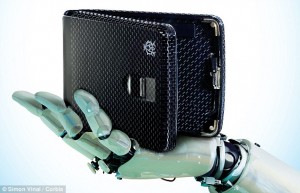When we think of wearable technology, we often imagine designs straight out of science fiction and unique futuristic materials. There are high-tech eyeglasses that take pictures, ultra biometric watches that track your sleep habits, and even vibrating shoe shoes that help you navigate the streets. In recent years, much of our everyday gear received high-tech upgrades but not much attention has been paid to the wallet.
Here is the object that houses nearly all of the valuables that a person carries on a daily basis: identification cards, credit and debit cards, and cash. With the massive security breaches at retailers Target and Neiman Marcus during the 2013 winter holiday season, it is abundantly clear that the magnetic stripes on credit cards are vulnerable to attack.

Chip-based credit and debit cards are a safer alternative to magnetic stripe cards because they are difficult for thieves to reproduce. There are two types: EMV and RFID. EMV smart-card technology (also known as “chip and pin”) is widely used internationally but the US has been very slow to adopt this technology, as it requires retailers to update their outdated equipment and financial institutions to rollout new cards. Radio Frequency Identification (RFID) card technology is the alternative but it comes with its own set of security-related challenges: anyone with a portable RFID reader can “read” the card data from a short distance.
For those unwilling to forgo credit and debit convenience, what technology is available to help protect our valuable card data? Some quick searching yielded the Omega titanium wallet and the biometric scanner wallet from Dunhill but both of these options (while futuristic and high-tech) are too clunky for daily wear (which defeats the basic function of a wallet) unless carried separately in a bag (impractical for some). Both draw unnecessary and perhaps unwanted attention to the wallet, which could make it a target for physical theft (which nullifies the purported security benefits).

Articulate Wallets (@A_Wallets) recently redesigned their eponymous wallet, keeping the RFID blocking technology but updating the design to suit the demands of modern life. Judging from the success of their Indiegogo project ($40,852 raised for $500 goal), there is a huge demand for wearable technology that offers consumer data protection with a less obtrusive “traditional” design. There is some irony that in the rush to put out the latest and greatest wearable technology, aesthetic wearability is sometimes forgotten.
So maybe there is hope on the horizon for those of us that want our wearables to look bit less Alienator … and thankfully, other forward-looking companies like LaForge Optical are also starting to take note.

Leave a Reply
You must be logged in to post a comment.